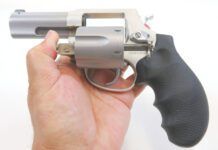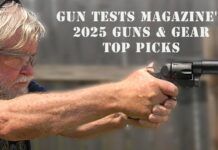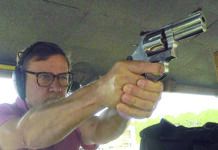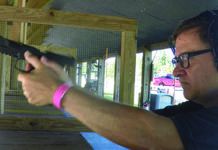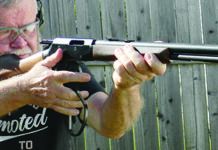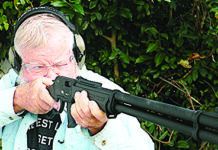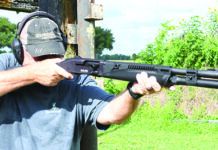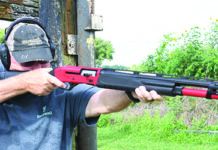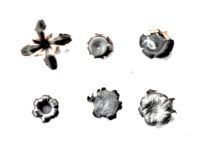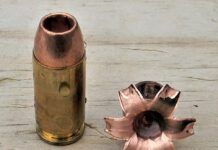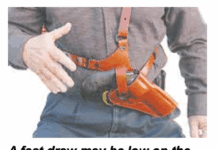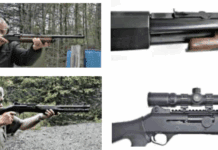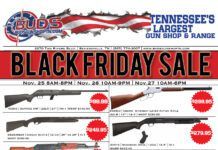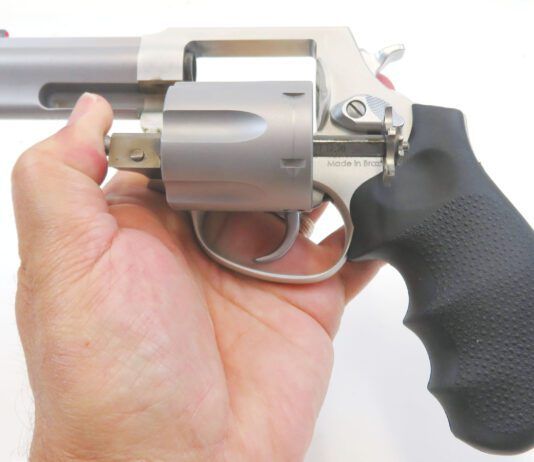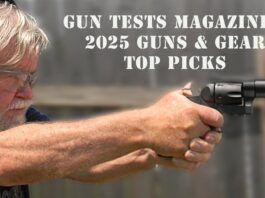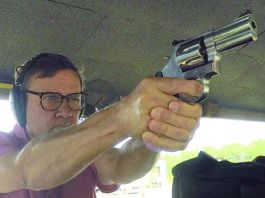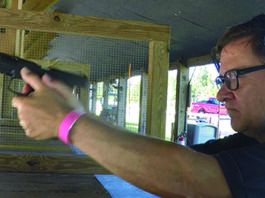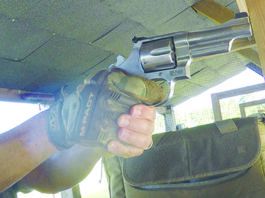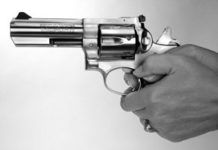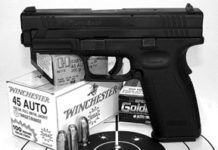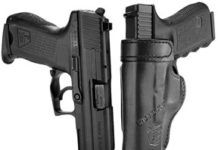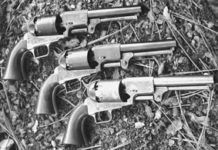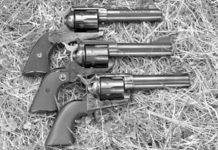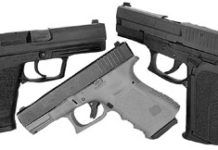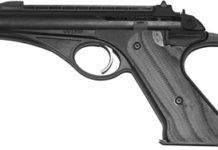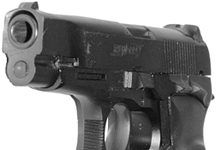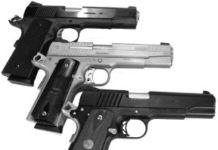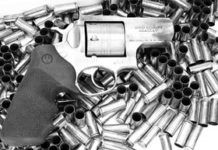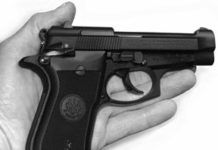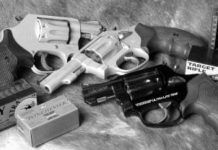.357 Mag. Service Revolvers: Ruger Outduels Taurus, S&W
We recently attended a major sporting event where security was provided by uniformed police. We couldn't help but notice how many officers, male and female were carrying revolvers instead of semi-automatic pistols. Never shy to interview, we took turns asking various officers why they had chosen a revolver. Here are some of the reasons they gave. "It can't be knocked out of battery." "The trigger doesn't change after the first shot." "I can get a really good action without worrying about reliability." "It was easy to find a replacement grip that fit me." "No mags to buy and this gun will last." "It didn't need any work to make it more accurate." Most of the guns we saw were .38 Special/.357 Magnums, which offer a wide range of power without affecting reliability.
Those practical answers to self-defense problems moved us to evaluate currently available service revolvers from Taurus, Smith & Wesson, and Sturm, Ruger. The most popular barrel length in a service or duty revolver is 4 inches, and such guns are now widely available with seven-shot cylinders. Our Taurus Model 66SS4, $469, was a seven-shooter, and so was our Smith & Wesson Model 619 No. 164301, $646. Only our $615 Ruger KGP-141, a member of the GP100 family, was limited to six rounds.
New Semi-Auto Power Pistols: Springfields XD 45 Is A Winner
Two recent pistol introductions have been much-ballyhooed in the gun press and firearms industry: Springfield's XD 45 and the Smith & Wesson M&P 40. At the NRA annual meetings in Milwaukee May 19-21, the new XD pistol in .45 ACP won Handgun of the Year notice from NRA's American Rifleman magazine, and it won Handgun of the Year at the Shooting Industry Academy of Excellence awards. The S&W M&P .40 was likewise nominated for the Shooting Industry award, and another NRA publication, Shooting Illustrated, named the M&P as its 2006 Handgun of the Year.
Because interest seems high, we wanted to weigh in on which pistol we thought was the best, so we acquired a $559 Springfield Armory XD (Extreme Duty), and a $624 Smith & Wesson M&P (Military and Police) pistol. Of course, both were designed to provide an effective weapon for law enforcement and military use, but they certainly will serve as personal defense guns for civilians that are durable, easy to maintain and within most budgets.
The XD is based on the Croatian police sidearm that Springfield Armory has adapted to the American market. Chambering the XD for .45 ACP is the latest volley aimed at landing the XD in the holster of every policeman. The XD is a proven design, but we wondered how the power and size of .45 ACP ammunition would affect the integrity of the machine as well as the friendly ergonomics that have attracted so many buyers in other chamberings. The Smith & Wesson M&P 40 S&W is the result of research and development that included consultation with the law enforcement and military training community. Starting with a clean slate, Smith & Wesson has risked much more than Springfield Armory by having to spend money on tooling up. Was it worth the investment?
.357 SIG Polymer Compacts: Glocks 32 Bests H&Ks P2000
What good is a defensive weapon without stopping power? "Not much," most self-defense handgunners would say in response. Thus, we all agree that an effective defensive handgun requires power, but the more nuanced question is, "How much?"
We recently treated ourselves to a head-to-head test of defensive handguns in an increasingly popular chambering, the .357 SIG. The round was designed to deliver the same amount of power as .357 Magnum ammunition fired from a 4-inch-barrel service revolver, which almost all shooters will agree is enough stopping power for a handgun. Moreover, the .357 SIG round provides more total firepower, because staggered-column "double-stack" pistol magazines hold much more ammunition than a revolver loaded with .357 Magnum rounds. Some agencies now recognize the round's effectiveness; notably the Texas Department of Public Safety has adopted the .357 SIG round in Sigarms P226 pistols for its troopers.
In this test we will look at two .357 SIG pistols that are small, light, and easy to conceal. The Glock 32 was one of the first polymer compact pistols chambered for .357 SIG. Our version of the model 32 was stock number KADO71, $599. Shooting against that was a Heckler & Koch P2000 Variant 3 No. 735203, $883. We picked this particular gun for our test because we were intrigued with the unique placement of the decocker.
Second Dragoons On Trial: We Rank Cimarron, Colt, and EMF
The Second Dragoon was the middle of three post-Walker revolvers developed by Colt beginning in 1848. All were designed for horseback use, and as such, weight was not much of a consideration, though at 4 pounds, the Dragoons weighed half a pound less than the Walker. There also was, most likely, ignorance about how heavy a revolver had to be in order to handle a given power level. For example, the 1860 Army Colt was not a lot less powerful than the Dragoon but weighed far less, yet was totally controllable, the result of ten years of refinement.
The Dragoon name comes from the use, or designated use, of this heavy pistol by the U.S. Mounted Rifles, some of which were called the Dragoons. Most originals, and all of our test trio, had the initials U.S.M.R. engraved on the cylinders. The Second Dragoon was in production from 1850-51, with a total of about 2,700 made. The First Dragoon was made from 1848 to 1850 in the quantity of about 7,000, and the Third Dragoon was made for about ten years, in the quantity of about 10,500. This makes the Second Dragoon the rarest of the original 4-pound Colts. In a similar manner, when Colt organized the production of the 2nd-Generation Dragoons in the early 1980s (built by Iver Johnson from I-J and Uberti parts), they made nearly 4,000 of the First, close to 7,000 of the Third, but only 2676 of the Second Dragoon, again rendering them the rarest of the lot. Easily distinguished by the square-back trigger guard and the rectangular bolt-stop notches, the Second Model Dragoon was originally presented with blued barrel, cylinder and trigger, and case-colored loading lever, hammer, and frame. The grip straps were brass, and grips were one-piece walnut. Some martial-use pistols had grips marked with an inspector's escutcheon. Our test EMF has such a mark.
Cowboy .38 Specials: EMF Is Our Pick, Ruger Gets A Buy Nod
Those who are most serious about Cowboy Action shooting tend to favor lighter-recoiling firearms so they can cut their times down, never mind that bigger guns like .45s tend to be more authentic, especially when stoked with black powder. Not that it takes any less skill to do well with lighter recoiling equipment, but it can give an edge, or so we've been told. This means .38 Special loads in handguns and rifles, and probably 20-gauge shotguns. How much benefit does a .38 Special offer over, say, a .45 Colt? There's a huge difference in recoil, even if the .45 shoots only light cowboy loads.
To find out more, we gathered a trio of .38 Special single-action six-shooters to see how well they'd do for us, and to find out how much we liked ‘em. All were .357 Mag-capable, and all had 4.75-inch barrels. The guns were a Ruger New Model 50th Anniversary Flat Top Blackhawk ($583), a Taurus Gaucho M38SA ($499), and from EMF Co., a resurrection of the old Great Western revolvers, the Great Western II "Californian" model ($450). We tested with three main types of ammo, Black Hills Cowboy loads, Federal 110-grain JHP .357 Mag, and with a modest handload in .38 Special cases that approximated Cowboy loads. Here's what we found.
.40 S&W Polymer Pistols: The Glock M23 Is A Proven Winner
Most shooters don't get too worked up about new polymer-framed auto pistols; they don't have the charm of a well-built 1911 .45 ACP or the character of an old Chiefs Special .38. Instead, what plastic guns do well is protect their owners, and in this defensive role, they excel. If you doubt this statement, simply check out what gun is riding on the hip of today's law-enforcement personnel. More often than not, it will be a polymer-framed high-cap 9mm or .40 S&W, and quite often, it will be a Glock.
Glock introduced the first successful plastic-framed pistol more than twenty years ago, and it is still the most popular polymer by a large margin. But several other manufacturers make comparable polymer pistols, and we recently tested two of such guns against the mainstay .40 S&W Glock Model 23.
Our first test product was the Heckler & Koch USP 40 Variant 9 .40 S&W USPLEM, $769. This design adds a manual thumb safety to the hinged-trigger USP pistol. Sigarms's latest polymer pistol, the SP2022 .40 S&W (No. E2022-40-BSS, $715), offers a decocker. Our Glock 23 .40 S&W No. HXL616 cost $670. All three guns came with night sights, and barrel length was approximately 4 inches.
In these guns we shot Winchester's 155-grain JHP Ranger loads, 180-grain hollowpoints from Black Hills Ammunition, and 165-grain FMJ rounds loaded to USPSA major caliber specifications by Georgia Arms (770-459-5117). This meant these rounds were expected to travel at an average velocity of at least 1000 fps from a 5-inch barrel.
For the testing, our shooters visited the comfortable confines of Top Gun of Texas (www.topgunrange.com), where we took advantage of the opportunity to adjust lighting conditions to test the effectiveness of each gun's night sights. Using the Black Hills rounds exclusively in this portion of our tests, we fired standing unsupported from a distance of 7 yards. We adjusted backlighting to provide just enough illumination to allow us to see a 3-inch circle on a Hoffners ABC16 target (www.hoffners.com). We recorded the first 10-round group we shot. Accuracy data from the bench was recorded at 15 yards, and we fired single action only from the Sigarms and HK pistols.
Our first question was whether or not the Glock SafeAction trigger, a full-time double-action system, would put the Model 23 gun at a disadvantage. Second, we asked if the addition of an active safety on the Heckler & Koch pistol or, the decocker on the Sigarms SP2022, added safety, or did these mechanisms hinder operation. Though we formed definite likes and dislikes about each gun, we found that they all ran trouble free with a variety of ammunition. Otherwise, let's get a detailed look at how well they shot in the text below:
A Brace of Full-Size .22 Autos: We Would Buy The Wolverine
Need a full-size .22 pistol? We've looked at smaller pistols and revolvers recently, but some want or need a larger .22 pistol, for whatever reasons. Happy to oblige, we grabbed two pistols that we thought would fill the hands better than anything smaller, and put them against each other in the hands of our test team. The pistols were the Whitney Wolverine ($280), Olympic Arms' remake of the Space-Age-looking older design which used to have an aluminum frame; and SIG's Mosquito ($390), a close copy of that company's larger pistols, with similar shape and finish but made somewhat smaller overall. The Wolverine was much lighter than the Mosquito, and it had a grip shape that not everyone will like. The Mosquito, which felt great in most hands, cost a bunch more. Was it worth it? Let's see what we found.
Low-Cost 9mms: Hi-Points C9 Vs. Bersas 18-Shot Thunder 9
The 9mm cartridge continues to retain its immense popularity, and those with little experience with firearms take to it quite well. Those with more experience know there are better self-defense rounds, but not many will argue that you can get ammunition for a 9mm at a cost far lower than most, if not all other, centerfire handgun cartridges. The handguns that shoot it are a different story altogether. The more-costly versions can easily run well into four figures, but most decent 9mm autoloaders sell for under a grand. But we know many folks can't justify spending even half that on a decent firearm. So how low can you go?
To find out, we chose two full-size 9mm pistols that might appeal to the buyer looking for a bargain. The first handgun we chose was the Hi-Point C9 with a suggested retail price of $140, but commonly selling for around a C-note or even less. We found one listed at $92. Can you expect such a handgun to work, much less work well? Our second pistol was the High-Capacity Bersa Thunder 9, just recently available. It lists for $442, or less if you shop around. While not inexpensive, the Bersa has several desirable features that many higher-priced handguns don't have, most notably its 17+1-shot capacity.
We tested these guns with Black Hills 147-grain JHP, Winchester 147-grain SXT JHP, and with Winchester 115-grain JHP ball. We shot for slow-fire accuracy at 15 yards from a solid rest, and for simulated self-defense fire with fast, controlled pairs from seven yards, using two hands. We also tried several other types of ammunition including Cor-Bon 125-grain JHP and Ultramax 115-grain lead-bullet loads for function or potential problems, but didn't report them formally. Here's what we found.
A Fresh Crop of Full-Size 1911s: We Choose the Para-Ord SSP
In this review we will evaluate three 1911 45 ACP pistols relatively new to the market. Each one was manufactured by names first associated with pistols other than the single-stack Browning design. For instance, Para-Ordnance is a Canadian firm most famous for introducing high capacity to the 1911 by enlarging the receiver to house a double-column magazine. STI International is known for its modular design melding a polymer grip to a set of rails to produce a high capacity pistol also fed from a double stack magazine. Sigarms has been making a single stack .45 for many years, the P220. But the P220 is closer to Browning's BDA design, operating with a traditional double-action trigger. Sigarms's single-action gun, the GSR Revolution, costs $1,049 and this puts it squarely between the $1,344 STI Lawman 5.0 and the $899 Para-Ordnance SSP.
We began our tests by removing the top ends of each gun and making sure they were properly lubricated. All three guns were function fired with a variety of ammunition left over from other tests, then loaded with at least 200 rounds of a handload featuring the 200-grain lead-swaged bullet from Precision Bullets (www.precisionbullets.com) that offered molybdenum coating to minimize deposits. Alliant Power Pistol smokeless powder was the propellant, ignited by Winchester large primers. We recorded accuracy data at an outdoor range from a 25-yard bench rest with this round plus three factory loads. They were 200-grain +P Speer Gold Dots, Federal's 165-grain Hydra-Shok JHP rounds, and the Atlanta Arms and Ammo 185-grain JHP match ammunition, (www.atlantaarmsandammo.com). This is the same load used by the United States Army Marksmanship Unit, (AMU). Our test team members believed that any full-size gun in this price range should deliver five-shot groups measuring approximately 2.5 inches or less and run without any problems. Let's see how these new .45s did when examined by our critical group of shooters:
Big-Bore Revolvers: For Power, Choose Rugers Super Redhawk
In this article we evaluate three guns that make no excuses for their girth. The Smith & Wesson Model 21-4 is a straightforward, large-frame revolver chambered for .44 Special only. Its .45 Colt brother, the Smith & Wesson Model 25-13, is slightly more modern, adding adjustable sights. The Ruger Super Redhawk Alaskan was fit with a longer cylinder, and together with its heavy frame, it is capable of firing .454 Casull as well as .45 Colt ammunition.
Our focus in this test was personal defense from humans and not bears, so we left the Casull rounds at home, but we did test an extra-heavy .45 Colt load from Atlanta Arms and Ammo formulated specifically for Ruger and Thompson Center firearms (
For our .44 Special rounds we chose 165-grain JHP rounds from Cor-Bon, Winchester's 200-grain Silvertip HP rounds, and 240-grain Truncated Cone Jacketed ammunition manufactured by Atlanta Arms and Ammo. Test distance was 25 yards from a sandbag rest. We fired single action only to collect hard data, but fired on steel targets double action only to evaluate rapid-fire capability. Limited to six-round capacity, we wanted to know which guns offered the right mix of power, accuracy, and speed. Here's what we learned:
A Trio of Pocket .380 ACPs: Steer Clear of NAAs Guardian
Whether or not the .380 ACP cartridge is your cup of tea, it exists in large numbers of available handguns today. Some of today's most modern ammunition make this cartridge a better one than it was, say, 30 years ago, but we would still not consider it for a main defensive weapon because we feel there are better caliber choices. Even the .45 ACP can be had in small packages.
We decided to look at a few of the .380 pocket pistols available, never mind the relative worth of the cartridge. After all, in a life-threatening situation any firearm is better than none, and a small, pocket-size gun is often more likely to be carried than anything bigger. We got a PPK Walther ($543), now being made in this smaller configuration by Smith & Wesson. The tiny North American Arms Guardian ($449) was the choice of one of our testers, despite the gun's being DAO. And the somewhat larger Beretta 85 FS Cheetah ($575) was also put up for consideration. Do these little .380s kick? How accurate are they? How easy are they to shoot fast? In this evaluation we looked hard at each gun's ability to make fast and reasonably accurate hits, but as always, we shot ‘em for group.
We tested with two types of hardball, CCI's Blazer and Brazilian Magtech, both with reloadable brass cases. We also used Cor-Bon's 90-grain JHP loads. We also tried a few groups with Federal's Personal Defense Hydra-Shok 90-grain JHP and Miwall's 88-grain JHP but didn't include these in the official results.
For the rapid-fire evaluations, we began with the gun in hand, and from a range of seven yards, brought the gun up and placed a shot onto a sheet of paper 8.5 by 11 inches in size. This was repeated until we got a good feel for each pistol, shooting each gun in the double-action mode. Then we tried each gun with two fast shots, which meant the Walther and Beretta were fired DA/SA, but of course the NAA Guardian was DA for both shots. We used these tests as a simple but practical evaluation of each gun's "combat" potential. We recommend the reader do similar testing if he buys such a gun with self defense in mind. Here's what we found.
Three Small .22 Wheelguns: We Loved the Taurus Ultra-Lite
Last month we reviewed a batch of Walther .22 semiauto pistols, and we have a couple more from other makers in the works. The autos shot well enough, but some shooters will never like self-loaders. Also, some folks don't want to leave behind all that brass, which the autos fling everywhere. The solution is to get a revolver, so — in keeping with our small-gun scenario — we gathered two of Smith & Wesson's feathery-light eight-shot revolvers, one with a 2.0-inch barrel and fixed sights ($633), the other with a 3-inch barrel and adjustable "HIVIZ" sights ($691). We also got a Taurus Ultra-Lite Nine ($375), which seemed to have a mix of the S&W's features at the cost of a significant weight penalty, but with the benefit of a huge price reduction.


